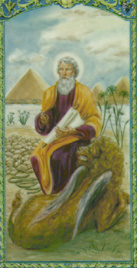Symbolism of the Fish
FREE Catholic Classes
Among the symbols employed by the primitive Christians, that of the fish ranks probably first in importance. While the use of the fish in pagan art as a purely decorative sign is ancient and constant, the earliest literary reference to the symbolic fish is made by Clement of Alexandria , born about 150, who recommends his readers (Paedagogus, III, xi) to have their seals engraved with a dove or a fish. Clement did not consider it necessary to give any reason for this recommendation, from which it may be safely be inferred that the meaning of both symbols was unnecessary. Indeed, from monumental sources we know that the symbolic fish was familiar to Christians long before the famous Alexandrian was born; in such Roman monuments as the Capella Greca and the Sacrament Chapels of the catacomb of St. Callistus, the fish was depicted as a symbol in the first decades of the second century.
The symbol itself may have been suggested by the miraculous multiplication of the loaves and fishes or the repast of the seven Disciples, after the Resurrection, on the shore of the Sea of Galilee ( John 21:9 ), but its popularity among Christians was due principally, it would seem, to the famous acrostic consisting of the initial letters of five Greek words forming the word for fish ( Ichthys ), which words briefly but clearly described the character of Christ and His claim to the worship of believers: Iesous Christos Theou Yios Soter , i.e. Jesus Christ, Son of God, Saviour. (See the discourse of Emperor Constantine, "Ad coetum Sanctorum" c. xviii.) It is not improbable that this Christian formula originated in Alexandria, and was intended as a protest against the pagan apotheosis of the emperors; on a coin from Alexandria of the reign of Domitian (81-96) this emperor is styled Theou Yios ( Son of God ).
 Hi readers, it seems you use Catholic Online a lot; that's great! It's a little awkward to ask, but we need your help. If you have already donated, we sincerely thank you. We're not salespeople, but we depend on donations averaging $14.76 and fewer than 1% of readers give. If you donate just $5.00, the price of your coffee, Catholic Online School could keep thriving. Thank you. Help Now >
Hi readers, it seems you use Catholic Online a lot; that's great! It's a little awkward to ask, but we need your help. If you have already donated, we sincerely thank you. We're not salespeople, but we depend on donations averaging $14.76 and fewer than 1% of readers give. If you donate just $5.00, the price of your coffee, Catholic Online School could keep thriving. Thank you. Help Now >
The word Ichthys , then, as well as the representation of a fish, held for Christians a meaning of the highest significance; it was a brief profession of faith in the divinity of Christ, the Redeemer of mankind. Believers in this mystic Ichthys were themselves "little fishes", according to the well-known passage of Tertullian (De baptismo, c. 1): "we, little fishes, after the image of our Ichthys , Jesus Christ, are born in the water".
The association of the Ichthys with the Eucharist is strongly emphasized in the epitaph of Abercius, the second century Bishop of Hierapolis in Phrygia, and in the somewhat later epitaph of Pectorius of Autun . Abercius tells us on the aforesaid monument that in his journey from his Asiatic home to Rome, everywhere on the way he received as food "the Fish from the spring, the great, the pure", as well as "wine mixed with water, together with bread". Pectorius also speaks of the Fish as a delicious spiritual nurture supplied by the "Saviour of the Saints". In the Eucharistic monuments this idea is expressed repeatedly in the pictorial form; the food before the banqueters is invariably bread and fish on two separate dishes. The peculiar significance attached to the fish in this relation is well brought out in such early frescoes as the Fractio Panis scene in the cemetery of St. Priscilla, and the fishes on the grass, in closest proximity to the baskets containing bread and wine, in the crypt of Lucina. (See S YMBOLISM OF THE E UCHARIST .)
The fish symbol was not, however, represented exclusively with symbols of the Eucharist; quite frequently it is found associated with such other symbols as the dove, the anchor, and the monogram of Christ. The monuments, too, on which it appears, from the first to the fourth century, include frescoes, sculptured representations, rings, seals, gilded glasses, as well as enkolpia of various materials. The type of fish depicted calls for no special observation, save that, from the second century, the form of the dolphin was frequently employed. The reason for this particular selection is presumed to be the fact that, in popular esteem, the dolphin was regarded as friendly to man.
Besides the Eucharistic frescoes of the catacombs a considerable number of objects containing the fish-symbol are preserved in various European museums, one of the most interesting, because of the grouping of the fish with several other symbols, being a carved gem in the Kircherian Museum in Rome. On the left is a T-form anchor, with two fishes beneath the crossbar, while next in order are a T-form cross with a dove on the crossbar and a sheep at the foot, another T-cross as the mast of a ship, and the good shepherd carrying on His shoulders the strayed sheep. In addition to these symbols the five letters of the word Ichthys are distributed round the border. Another ancient carved gem represents a ship supported by a fish, with doves perched on the mast and stern, and Christ on the waters rescuing St. Peter.
After the fourth century the symbolism of the fish gradually disappeared; representations of fishes on baptismal fonts and on bronze baptismal cups like those found at Rome and Trier, now in the Kircherian Museum, are merely of an ornamental character, suggested, probably by the water used in baptism.









 Daily Readings for Thursday, April 25, 2024
Daily Readings for Thursday, April 25, 2024 St. Mark: Saint of the Day for Thursday, April 25, 2024
St. Mark: Saint of the Day for Thursday, April 25, 2024 Prayer for Policemen: Prayer of the Day for Thursday, April 25, 2024
Prayer for Policemen: Prayer of the Day for Thursday, April 25, 2024


